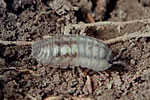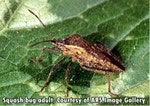Sow Bugs

Rolly-pollies, pill bugs: The names may be different, but the shape is the same. They look like one centimeter (more or less) blunted armadillos with antennae. Color varies from all shades of grey, to brown, to black, with exotic shades of blue thrown in for good measure. You touch them and they curl up into little balls. They are odd creatures, but not strange insects; they are strange crustaceans. They live under leaf litter, plant debris, within organic matter, and under logs and rocks. They are not terrible plant pests — especially if the plants you’re growing are well established and the sow bugs are in small numbers. If, however, you’re dealing with large numbers of these creatures, or if your plants are mere seedlings, sow bugs can become overwhelming. So what’s to be done? Upon talking to some people who’ve had to deal with them, some solutions were offered. One was a saucer of beer (like that which is sometimes effective for slug and snail control) used to lure and trap these “bugs”. Another simple remedy which was mentioned was to sprinkle corn meal in areas where these pests are seen. Our understanding is that they eat the stuff and can’t digest it. The general consensus has been that the corn starch disappears, the sow bugs thin, and the people who’ve tried it don’t really know to what it should be attributed. Another suggested the use of European quail. The person who suggested this uses these biocontrol agents in a conservatory which was once plagued with sow bugs. The sow bugs are kept in control by the birds. If the situation can tolerate the birds, why not? There many are other recipes for success-mostly baits to poison or trap these creatures. But if none of it works, flipping over logs and stones and debris every morning and simply squashing these pests will.
Spittlebugs
Ever see a plant which looked like someone spit of it? The spit was probably from spittlebugs. They produce and live in this frothy excretion. The bugs themselves are rarely seen, but average about six millimeters in size and are usually pale yellow in color. They do suck plant juices and, if in abundant numbers, may cause some stunting of plants, but we’ve never heard anyone truly complain about feeding damage or virus transmission as of a result of the presence of these insects. Most comments are directed to the discomfort of offering plants for sale with globs of spit tucked into the branches. Though it is nothing some hose-water can’t take care of. In some crops spittlebugs’ er, nests, are commonly seen. Strawberries is one. You can actively disrupt them with hose water, and yields were excellent.
Spruce Budworms
The larvae of these three centimeter nondescript gray-colored moths are serious pests of conifers. The caterpillars tunnel into needles, twigs, buds and cones of several types of coniferous trees causing extensive damage yearly to conifer-offering nurserymen. Also affected are those who grow Christmas trees and those in the lumber industry. Fortunately, Bacillus thuringiensis (K) (Bt) variety Kurstaki, if sprayed at the right time, will control these pests. Do, however, expect to have to spray a lot of the bacteria-containing substance, especially if you have a large stand to treat (and this is likely with these caterpillars). Trichogramma spp. moth-egg parasitoids may also impact populations of this pestiferous moth species. Again, though, timing will be important. Other non-chemical remedies, to the best of our knowledge, do not exist. Good luck.
Squash Bugs

Growing to two centimeters, these dark patterned shield-shaped true bugs can be very damaging to squash, melons and others of that family. Their feeding will cause whole shoots to wilt and eventually die back completely as they drain away the plants’ life-giving juices. We wish we could tell you about all kinds of excellent controls for squash bugs, but we can’t. They have no commercially-produced natural enemies. Nor are they taken down by Parasitic Nematodes or Bacillus thuringiensis (Bt) strains. Row covers are effective if used until pollination is needed and are placed over planting spaces free of leaf litter and plant debris. Experimentally, we suppose, spined soldier bugs, Podisus maculiventris, could be lured or introduced into a the melon patch — they’re very opportunistic and may predate the squash bugs’ nymphs, but we’re not sure. Moreover, products containing garlic or capsicum wax may repel these pests, or deter their feeding.
Squash Vine Borers
The larvae of these moths are not just interested in squash plants as their names implies, they love many of the cucurbits. The moths are red and gray-black and quite large at approximately three to four centimeters in length. The adults are not damaging, though. They lay their eggs near the base of their preferred plants, and the resulting larval forms burrow into the plants. It is they who cause the stem wilting and dieback. Row covers provide a means of preventing the moths from laying their eggs. However, since the plants require pollination, the covers must be removed when flowering begins. Parasitic Nematodes provide another avenue of control, but must be introduced at the proper time — as the eggs are hatching but before the larvae have a chance to bore into and enter the crown and stems. If your timing is not right, you can still gain the upper hand by injecting the nematodes into the affected stems by way of the bored holes, but this is not a practical solution in anything other than a small scale plot. The injection method of applying nematodes is very time-consuming. Speaking of time consuming, it has been recommended in some books to perform surgery on affected plants by slitting the stem and physically removing the larvae. Additional control can be obtained from azadirachtin, the active ingredient in neem-based products.
Strawberry Root Weevils

These black, armored weevils grow to about eight millimeters and can be major strawberry pests. Moreover, they can impact other fruits, including cane berries, grapes, fruit trees and even some conifers. Like black vine weevils, these insects distinctively notch the leaves of their victims. Additionally, their presence is also felt in the root zone where the larval stages of these pests also feed. Also like black vine weevils, on a very positive note, strawberry root weevils are efficiently controlled with Parasitic Nematodes. Temporary control, due to pollination requirements, can be obtained in certain crops by covering them with a floating row cover. However, this may contain those weevils which began life in the soil of the root zone of the covered plants. It is, therefore, necessary to treat with nematodes prior to covering the plants. Other goods, like garlic and capsicum wax sprays may help repel these pests or deter them from feeding.
